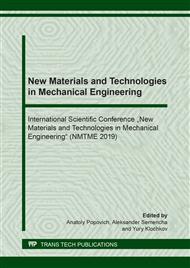[1]
Asheichik AA, Bahrami MR. Investigation of Graflon Antifriction Feature under Friction in Seawater. Procedia Engineering. 2017 Jan 1;206:642-6.
DOI: 10.1016/j.proeng.2017.10.530
Google Scholar
[2]
Koltsova TS, Breki AD, Larionova TV, Tolochko OV. OPERATIONAL CHARACTERISTICS OF THE COMPOSITE ALUMINUM-CARBON NANOFIBERS. Materials Physics and Mechanics. 2018 Jan 1;38(1):11-5.
Google Scholar
[3]
Kolesnikov Y.V., Morozov E.M. Contact damage mechanics. Ed. 4-С. — М. Publisher LKI, 2012. — 224 p.
Google Scholar
[4]
Skotnikova MA, Eliseev VV, Moskalets AA, Krylov NA. Application of the theory of contact elastic deformations for assessing the risk of destruction of turbine blades as a result of high-speed impact by steam particles. International Review of Mechanical Engineering. 2017;11(5):350-5.
DOI: 10.15866/ireme.v11i5.11600
Google Scholar
[5]
Breki AD, Kol'tsova TS, Skvortsova AN, Tolochko OV, Aleksandrov SE, Kolmakov AG, Lisenkov AA, Gvozdev AE, Fadin YA, Provotorov DA. Tribotechnical Properties of Composite Material Aluminum–Carbon Nanofibers, under Friction on Steels 12Kh1 and ShKh15. Inorganic Materials: Applied Research. 2018 Jul 1;9(4):639-43.
DOI: 10.1134/s207511331804007x
Google Scholar
[6]
Boichuk A.S., Generalov A.S., Dalin M.A., Stepanov A.V. Non-destructive testing of technological discontinuities of the T-shaped zone of the integral structure made of PCM using phased ultrasound arrays// Journal «All materials. Encyclopedic reference». – М., 2012. — No10 — p.38 — 44.
Google Scholar
[7]
Cherkashin AV, Pykhtin KA, Begich YE, Sherstobitova PA, Koltsova TS. Mechanical properties of nanocarbon modified cement. Инженерно-строительный журнал. 2017(4):54-61.
Google Scholar
[8]
Mitryaikin V.I., Mikhailov S.A., Bugakov I.S., Zakirov R.H. Non-destructive testing of composite structures with a computer tomograph: Monograph. Kazan. Publisher Kazan. state tech. Univercity, 2011. — 192 p.
Google Scholar
[9]
Kondrat'ev SY, Anastasiadi GP, Petrov SN, Ptashnik AV, Svyatysheva EV. Morphological Characteristics of Chromium Carbides in HP40NbTi Refractory Alloys in Cast Condition and after High-Temperature Holds. Metal Science and Heat Treatment. 2016 May 1;58(1-2):19-26.
DOI: 10.1007/s11041-016-9958-y
Google Scholar
[10]
Mikhailin Y. A. Structural Polymer Composite Materials. Ed. 2. — S-Petersburg. Scientific background and technology, 2010. — 822 p.
Google Scholar
[11]
Rudskoy AI, Belov IM, Gordeev SK, Barzinskii OV, Kondrat'ev SY. Carbon Nanostructured Implants for Substituting Bone Defects and Process of Their Production. Metal Science and Heat Treatment. 2018 May:1-6.
DOI: 10.1007/s11041-018-0234-1
Google Scholar
[12]
Kulik T.A., Kochergin Y. S., Zaitsev Y.S., Pakter M.K., Askadskij А.А. The effect of liquid rubbers on the physico-mechanical properties of epoxy polymers// Plastics. Ed. 4, 1985. — pp.25-26.
Google Scholar


